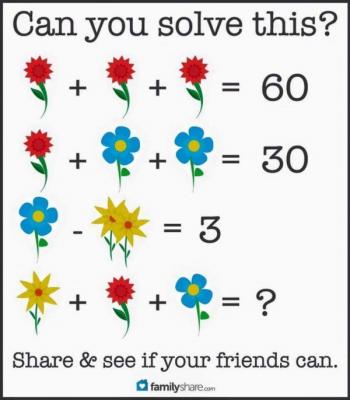Ask Professor Puzzler
Do you have a question you would like to ask Professor Puzzler? Click here to ask your question!
Seventh grader Colton from Florida asks, "If triangles have the same area, are they similar? Or do triangles have to have the same perimeter to be the same? I think it's area. Thank you "
Hi Colton!
Thanks for your question. I want to make sure we're talking about the same thing here. In one question you talk about triangles being "similar" and in the next you talk about them being "the same." These are two very different questions, that use very different concepts.
You see, triangles could be congruent (what you might have meant when you said "the same") or they can be similar.
So what is the difference?
Congruent means that two triangles are identically shaped. The have the same shape and the same size. They have three pairs of sides that are the same length, and they have three pairs of angles that are the same measure. We call the pairs of parts "corresponding parts," and we say that in congruent triangles, "Corresponding parts of congruent triangles are congruent" (which gets shortened, often, to "CPCTC").
Another way of saying that: if you have two triangles that are congruent, you could pick one of them up and set it down on top of the other, and they would match perfectly. You might have to flip or rotate the one you picked up, but if you can't make it line up perfectly on the other triangle, they aren't congruent. In the image below, the triangles are congruent, because you could pick up the one on the right, rotate it about 45 degrees counter clockwise, and it would fit exactly on top of the triangle on the right.
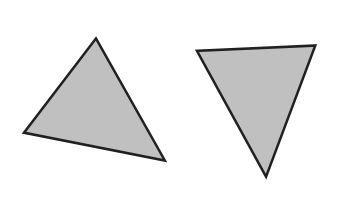
As for your question: if two triangles have the same area, are they congruent? Not necessarily! I can create two triangles that take up the same amount of space, but have very different shapes. And the same is true of perimeter; just because two triangles have the same perimeter, that doesn't mean they're the same shape.
There are ways to tell if two triangles are congruent. For example, if you have two pairs of sides that are the same length, and the pair of angles between those sides is congruent, then it's guaranteed that the two triangles are congruent. Maybe in another blog post I'll explore all the different congruence theorems!
But now we need to consider similarity. Similarity is different from congruence. Two triangles can be similar without being congruent. Two triangles are similar if they have the same shape, but not necessarily the same size. What do I mean by "same shape?" Well, one way of explaining it is to say that all of their pairs of angles are congruent.
Or, imagine that you have two similar triangles printed on transparencies. You might not be able to lay one on top of the other so that they match, but if you hung one of them on the wall, and used a projector to project the other one onto the wall, you could make them line up by getting the projector the right distance from the wall.
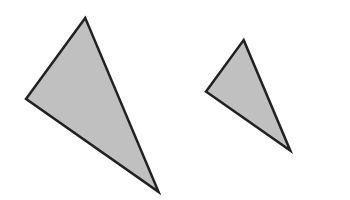
This picture is an example of two triangles that are similar. You can see the shape is the same; they both have two smallish angles, and one bigger angle. You couldn't lay one of them on top of the other and have them match perfectly, but if you expanded the smaller one, you could make it fit perfectly on the larger one. They are similar.
Okay, so now we come back to your question: if two triangles have the same area, or the same perimeter, are they similar? Not necessarily! You could have two triangles with the same perimeter (or the same area) that aren't the same shape at all. And if they're not the same shape, they're not similar!
So, in conclusion, neither the area nor the perimeter will help you determine if two triangles are similar, or determine if they are congruent!
That's a pretty long answer to a short question, but hopefully you learned some important concepts along the way.
Thanks for asking your question, Colton.
Sincerely,
Professor Puzzler
I don't normally do follow-up posts on subjects I've already written up, because most of the time when I get e-mailed questions or comments about things I've written, I feel like they are best suited to a discussion in our community forum, rather than creating extra blog posts. However, this particular question, even though it is a follow-up to the Apples, Bananas, and Coconuts blog post, is worth analyzing in its own right, independent of the previous blog post.
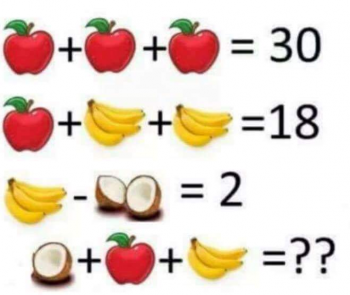
In the image shown here, the challenge was to find the value of an apple, three bananas, and half a coconut. There are multiple ways of assigning meaning to the images. For example, your basic banana "unit" could be 1 banana, or it could be 1 banana bunch (in which case, the last line contains 3/4 bunch!).
Similarly, your basic coconut unit could be a coconut, or a half-coconut. How you define these will affect how you work out the problem, but does not affect the solution.
One reader was concerned by the fact that you can end up with two variables having the same value: a half-coconut has the same value as a banana, and "this is not algebraically correct, as in algebra, X & Y cannot both be equal to one."
And this is the question we're exploring here: Can two variables have the same value in a problem?
The question-writer is not the only one who gets flustered by this possibility -- I have algebra students who get flummoxed every time I give them a problem in which both X and Y have the same value; they are convinced they must have done something wrong! In fact, just last week I gave my algebra students a system of three equations in three unknowns, in which the variables x, y, and z all were equal to one.
Really, there is no algebraic reason why two variables can't have the same value.
First, let me give you a graphical representation of an equation. Consider the following equation: y = 4 - x. If you graph it, it looks like this:
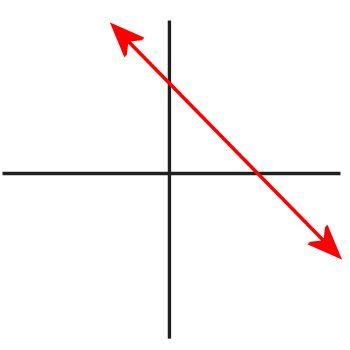
But what does that graph mean? It is simply a graphical representation of every ordered pair (x,y) that satisfies the equation. The red line is an infinite series of x and y values that make the equation true. But did you realize that there's a point in that graph for which x and y have the same value? It's true! It's the point x = 2, y = 2, because 2 = 4 - 2. If having two variables with the same value was illegal, then your algebra teacher would have taught you to graph the equation like this instead, leaving out the point (2,2):
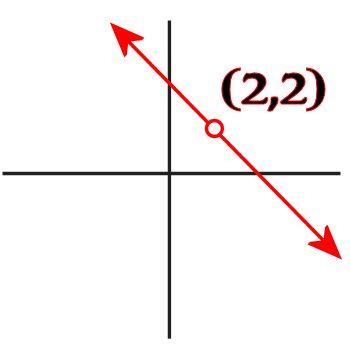
But your teacher didn't tell you to graph lines like this. Why? Because it's perfectly okay for two variables to have the same value!
There are practical implications that would result from supposing that x and y can't have the same value, because algebra was designed to have real-world application. Imagine an accident reconstruction expert is trying to figure out what happened when two vehicles collided. He sets up equations, assigning variables to all his unknowns, plugs in the values he does know, and then calculates the values of his uknowns.
Then, when he gets to the end of his calculations, he says, "Wait! This accident can't possibly have happened! Because the initial speed of the first car was 45 mph, and the initial speed of the second car was also 45 mph! We can't have the same value for two variables!"
No, of course he doesn't say that! In fact, if the speed limit was 45 mph, he'll just smile and say, "At least they were both going the speed limit!"
Or suppose you go shopping, and you pick up a bag of apples and a bag of pears. The bag of apples has 20 apples, and costs $4.00. The bag of pears has 10 pears, and costs $2.00. You think, "I wonder what is the cost of a single apple, and the cost of a single pear?" So you do set up two equations: 20a = 4 and 10p = 2, and to your horror, find that both apples and pears cost the same per fruit "That can't be right," you say, as you hurriedly put the fruit back on the shelf, "I had two variables, and they both came out to the same value!"
Of course not! You'll buy the apples and the oranges at the same unit price, and the universe won't explode! Because, you see, the real world doesn't really care about whether two quantities are equal or not. The values are what they are, and life goes on.
Someday I'm going to write a system of 26 equations in 26 unknowns, in which all 26 variables have the same value. My students' brains might explode, but nothing else will!
The following picture (click it for a larger version) was seen on Facebook by my outlaw Jakob (his wife is my sister-in-law, which is why I refer to him as my outlaw). It was accompanied by the caption "Here Is The Reason Why 1 Is Called 1. , And 2 Is Called 2..."
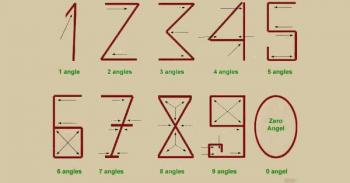
Somehow, Jakob must have known that I would want to write a sarcastic, cynical post about this.
So let's start with the caption.
"Here Is The Reason Why 1 Is Called 1. , And 2 Is Called 2..."
Uh...no...your terminology is confused. "1" is not what the number is called; it's called "one." "1" is the grapheme for the number we call "one."
So I guess you meant to say "Here is the reason we use this grapheme for one, and that grapheme for two..."
Better?
No. Not at all. Historically, there is absolutely no reason to think that people invented their numerical graphemes based on the number of angles in the digits (mind you, there is some indication that various civilizations played with creating graphemes based on making the number of lines match the numeral being represented). Most of our digits went through a lengthy evolution process, and their original forms, like our modern forms, had far more curves than angles. Take the number three, for example. The number three has no angles at all. Neither does six, eight, or nine.
"Well sure," you might say, "but if you write it as a block numeral, with straight lines, then the grapheme for three has three angles."
Really? So why didn't you write zero that way? Because when I last checked, a zero has four angles when written in block form.
And let's face it, even if you want to write your numbers in block form, no one writes them like this. Check your calculator. A two is an inverted five, which means that, like five, it has four angles. Four. Not five. Not two. Four.
And that ridiculous looking seven? Some people put a hook at the top of their sevens. Some people put a line through the middle. But do you know anyone who puts a line at the bottom of their sevens? I've been teaching math for a long time, and I don't think I've ever seen anyone write a seven with that serif. Oh, and I just checked through all 150 fonts I have installed on my computer, and none of them have that. It's just silly.
Do we really even need to talk about that absurd nine? Who in the world puts a curl on the curl on the curl at the bottom of their nines?
I get to the end of their numbers and find myself wondering, "Why? Why?? Why does this thing even exist?"
I have no idea. Seriously.
It's not even a valuable mnemonic for remembering anything. It's purposeless. And on top of that, it has zero angels. What's up with that? Why even mention angels, if you're not going to include any?
As one commenter said, "I never looked at the digits this way before. And now I'm never going to do it again."
Thanks, outlaw!
Today's post is about a picture that has been mystifying and frustrating people. Frustrating because it seems so blatantly and completely wrong. Mystifying because people in the know just smile knowingly as though it's a joke.
Some jokes need to be explained, so here's the picture:
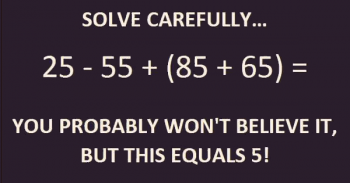
It seems quite clear, doesn't it? PEMDAS gives us our order of operations. We evaluated 85 + 65 first: 85 + 65 = 150.
So now we have 25 - 55 + 150, which should be evaluated in order from left to right: 25 - 55 = -30, and -30 + 150 = 120.
So how in the world did they get 5?
The answer is: they didn't get 5. They got 5!
You see, this is one of those horrible times when mathematics hijacks innocent punctuation marks and forces them into hard labor for nefarious, non-grammatical purposes.
The exclamation mark is used in mathematics not to epxress excitement or astonishment, but to indicate that we are calculating the factorial of a number.
What's a factorial? A factorial is what you get when you multiply all the integers between 1 and some number. For example, 6! = 6 x 5 x 4 x 3 x 2 x 1 = 720.
So before we declare this image bogus and invalid, we probably should check to find out what 5! equals.
5! = 5 x 4 x 3 x 2 x 1 = 120.
Oh! (And I'm using that exclamation mark to indicate astonishment) it really does equal 5!
And if I'm truly astonished, I might say that it equals 5!!
Except someone might get hoodwinked into thinking I meant 120!, which is about 6.8 x 10198. That's not what I meant. I promise. I'm just that excited!
What is the solution to the following puzzle that's been going around facebook?

The answer is, on the surface, not terribly difficult to find:
3 apples = 30, so 1 apple = 10.
10 + 2 bananas = 18, so 2 bananas = 8 and 1 banana = 4
4 - 1 coconut = 2, so 1 coconut = 2
Therefore, 1 coconut + 1 apple + 1 banana = 2 + 10 + 4 = 16
HOWEVER...
Although this is the answer everyone seems to be giving, it's actually not correct. Notice that each bunch of bananas has four bananas (look closely!) except the one in the final line, which has 3 bananas. Also notice that the third line has one coconut, while the last line has only 1/2 of a coconut.
This changes things!
3 apples = 30, so 1 apple = 10.
10 + 8 bananas = 18, so 8 bananas = 8 and 1 banana = 1
4 - 1 coconut = 2, so 1 coconut = 2
Therefore, 1/2 coconut + 1 apple + 3 bananas = 1 + 10 + 3 = 14
This is a really nice problem, since it gives you a good reminder to pay attention to details!
Click the image below to read Professor Puzzler's analysis of another puzzle:
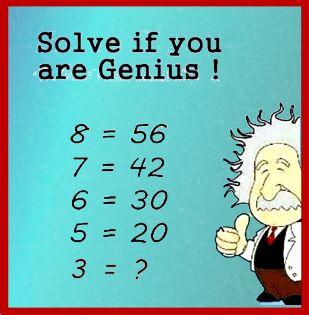
Addendums
William from Phoenix asks, "Apples coconuts bananas: The editing to remove the fourth banana was incomplete. it left the end point in the picture on line four. Was that intentional to cause controversy with your answers?"
Honestly, William, I can't see the incomplete erasure you're talking about. I don't doubt you, but I'm not seeing it. But, since you asked, I'll take this opportunity to point out: I didn't create this problem; I just wrote up the solution for people who wanted to know. If I had to make a guess, I would say that the person who created it did not intentionally leave part of a banana; they probably were just inexperienced with photoshop, or were in a hurry when they created it!
Colton from Florida had a question about the Algebra of this problem, which we answered here: Can X and Y have the same value?
Pany from UK points out that there is another way to interpret the problem, in which we regard each image as a symbolic variable, rather than as collections of real world objects. While I don't agree with him that this is the best way of looking at it, it is absolutely a valid way of viewing the problem, and it results in a very different problem, which is unsolvable, because we have more variables than equations. And speaking of which...
Anne from Maine shared with us a similar looking problem with a very different solution. Click the image below to read that post:
